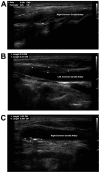Effect of menopausal status on carotid intima-media thickness and presence of carotid plaque in Chinese women generation population
- PMID: 25627797
- PMCID: PMC4308700
- DOI: 10.1038/srep08076
Effect of menopausal status on carotid intima-media thickness and presence of carotid plaque in Chinese women generation population
Abstract
Menopause is an important physiological stage in women's life. The potential association of menopause with carotid intima-media thickness as well as with occurrence and stability of carotid plaque in Chinese female population is unclear. We conducted a population-based, cross-sectional study by recruiting 2,131 participants aged above 40 years from northeast of China. Carotid intima-media thickness (CIMT), presence of carotid plaque and its stability were evaluated by carotid duplex sonography. Among the participants, 1,133 (53.2%) were identified to be postmenopausal. After adjusting for potential confounding factors, presence of CIMT at 50(th-) 75(th) and ≥75(th) percentiles, carotid plaque and its unstable status were found to be significantly associated with the postmenopausal status (P < 0.001). When matched the participants by age, post-menopausal status was still associated with a higher risk of having unstable plaque. Moreover, our data show that postmenopausal status is a risk factor for intracranial arterial stenosis when compared with premenopausal status in the univariate analysis (OR = 1.314, P = 0.043), and such relationship is lost when the confounding factors are adjusted (OR = 0.828, P = 0.225). In conclusion, the vascular risk factors increase as the menopausal status changes. Compared with premenopausal status, postmenopausal status is associated with higher morbidity of CIMT, carotid plaque and its unstable status.
Figures
Similar articles
-
Difference in carotid intima-media thickness between pre and postmenopausal women.Menopause. 2019 Jan;26(1):39-44. doi: 10.1097/GME.0000000000001159. Menopause. 2019. PMID: 29975281
-
Carotid intima-media thickness and osteoporosis in postmenopausal women: a cross-sectional study.Climacteric. 2018 Jun;21(3):280-285. doi: 10.1080/13697137.2018.1439916. Epub 2018 Mar 9. Climacteric. 2018. PMID: 29521130
-
Relationship between serum osteocalcin level and carotid intima-media thickness in a metabolically healthy Chinese population.Cardiovasc Diabetol. 2015 Jun 16;14:82. doi: 10.1186/s12933-015-0245-9. Cardiovasc Diabetol. 2015. PMID: 26077201 Free PMC article.
-
Carotid plaque, compared with carotid intima-media thickness, more accurately predicts coronary artery disease events: a meta-analysis.Atherosclerosis. 2012 Jan;220(1):128-33. doi: 10.1016/j.atherosclerosis.2011.06.044. Epub 2011 Jun 30. Atherosclerosis. 2012. PMID: 21764060 Review.
-
Is carotid intima-media thickness as predictive as other noninvasive techniques for the detection of coronary artery disease?Arterioscler Thromb Vasc Biol. 2014 Jul;34(7):1341-5. doi: 10.1161/ATVBAHA.113.302075. Epub 2014 Apr 24. Arterioscler Thromb Vasc Biol. 2014. PMID: 24764454 Review.
Cited by
-
Classical Cardiovascular Risk Factors and HIV are Associated With Carotid Intima-Media Thickness in Adults From Sub-Saharan Africa: Findings From H3Africa AWI-Gen Study.J Am Heart Assoc. 2019 Jul 16;8(14):e011506. doi: 10.1161/JAHA.118.011506. Epub 2019 Jul 13. J Am Heart Assoc. 2019. PMID: 31304842 Free PMC article.
-
Association of baseline Life's Essential 8 score and trajectories with carotid intima-media thickness.Front Endocrinol (Lausanne). 2023 Jun 2;14:1186880. doi: 10.3389/fendo.2023.1186880. eCollection 2023. Front Endocrinol (Lausanne). 2023. PMID: 37334294 Free PMC article.
-
Gender difference in the response to valsartan/amlodipine single-pill combination in essential hypertension (China Status II): An observational study.J Renin Angiotensin Aldosterone Syst. 2016 Apr 28;17(2):1470320316643903. doi: 10.1177/1470320316643903. Print 2016 Apr-Jun. J Renin Angiotensin Aldosterone Syst. 2016. PMID: 27127102 Free PMC article.
-
Association between high-sensitivity C-reactive protein, lipoprotein-associated phospholipase A2 and carotid atherosclerosis: A cross-sectional study.J Cell Mol Med. 2018 Oct;22(10):5145-5150. doi: 10.1111/jcmm.13803. Epub 2018 Aug 9. J Cell Mol Med. 2018. PMID: 30094934 Free PMC article.
-
Predictors of subclinical atherosclerosis in asymptomatic healthy non-diabetic postmenopausal women.Clin Physiol Funct Imaging. 2025 Jan;45(1):e12920. doi: 10.1111/cpf.12920. Clin Physiol Funct Imaging. 2025. PMID: 39688094 Free PMC article.
References
-
- Isles C. G., Hole D. J., Hawthorne V. M. & Lever A. F. Relation between coronary risk and coronary mortality in women of the Renfrew and Paisley survey: comparison with men. Lancet 339, 702–706 (1992). - PubMed
-
- Gordon T., Kannel W. B., Hjortland M. C. & McNamara P. M. Menopause and coronary heart disease. The Framingham Study. Ann Intern Med 89, 157–161 (1978). - PubMed
-
- Barrett-Connor E. & Bush T. L. Estrogen and coronary heart disease in women. Jama 265, 1861–1867 (1991). - PubMed
MeSH terms
LinkOut - more resources
Full Text Sources
Other Literature Sources


